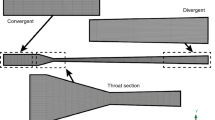Abstract
The goal of wind tunnel design is to generate a uniform air flow with minimum turbulence intensity and low flow angle. The nozzle is the main component of wind tunnels to create a uniform flow with minimal turbulence. Pressure distribution along nozzle walls directly affects the boundary layer thickness, pressure losses and non-uniformity of flow velocity through the test section. Although reduction of flow turbulences and non-uniformity through the test section can be carried out by nozzles with high contraction ratio, it increases the construction cost of the wind tunnel. For decreasing the construction cost of nozzle with constant test section size and mass flow rate, the contraction ratio and length of nozzle should be decreased; that causes the non-uniformity of outlet velocity to increase. In this study, first, three types of nozzle are numerically investigated to compare their performance. Then, Sargison nozzle with contraction ratio of 12.25 and length of 7 m is scaled down to decrease its weight and construction cost. Having scaled and changed to a nozzle with contraction ratio of 9 and length of 5 m, its numerical solution reveals that the non-uniformity of outlet velocity increases by 21%. By using the Ballspine inverse design method, the pressure distribution of the original Sargison nozzle is first scaled and set as the target pressure of the scaled down nozzle and geometry correction is done. Having reached the target nozzle, numerical solution of flow inside the optimized nozzle shows that the non-uniformity just increases by 5% in comparison with the original Sargison nozzle.
Similar content being viewed by others
References
M. A. Ardekani, Subsonic wind tunnel, K. N. Toosi University of Technology, Tehran, Iran (2009) (In Persian).
J. B. Barlow, J. William, H. Rae and A. Pope, Low-speed wind tunnel testing, 3rd Ed., Wiley (1999).
P. Bradshaw, Effects of streamline curvature on turbulent flow, AGARD, vol. -AG-169 (1973).
J. P. N. Saddoughi, Lateral straining of turbulent boundary layers, J. of Fluid Mechanics, 229 (1991) 173–204.
M. A. Ardekani, Optimization of a vertical wind tunnel nozzle length using numerical and experimental methods, J. of Solid and Fluid Mechanics, 3 (3) (2013) 137–147 (In Persian).
P. Garabedian and G. McFadden, Computational fluid dynamics of airfoils and wings, J. Scientific Computing (1982) 1–16.
P. Garabedian and G. McFadden, Design of supercritical swept wings, AIAA J., 20 (1982) 289–291.
J. Malone, J. Vadyak and L. Sankar, Inverse aerodynamic design method for aircraft components, J. of Aircraft, 24 (1987) 8–9.
J. Malone, J. Vadyak and L. Sankar, A technique for the inverse aerodynamic design of nacelles and wing configurations, AAIA paper, AAIA-85-4096 (1985).
J. Malone, J. Narramore and L. Sankar, An efficient airfoil design method using the Navier–Stokes equations, AGARD (1989) 5.
G. S. Dulikravich and D. P. Baker, Using existing flow-field analysis codes for inverse design of three-dimentional aerodynamic shapes, Recent Development of Aerodynamic Design Methodologies: Springer (1999) 89–112.
R. L. Barger and C. W. Brooks, A streamline curvature method for design of supercritical and subcritical airfoils, NASA TN D-7770 (1974).
R. L. Campbell and L. A. Smith, A hybrid algorithm for transonic airfoil and wing design, AIAA Paper 87-2552 (1987).
R. A. Bell and R. D. Cedar, An inverse method for the aerodynamic design of three-dimensional aircraft engine nacelles, Dulikravich (1991) 405–417.
J. B. Malone, J. C. Narramore and L. N. Sankar, An efficient airfoil design method using the Navier-Stokes equations, AGARD (1989).
M. Nili-Ahmadabadi, M. Durali, A. Hajilouy-Benisi and F. Ghadak, Inverse design of 2-D subsonic ducts using flexible string algorithm, J. Inverse Problems in Science and Engineering, 17 (2009) 1037–1057.
M. Nili-Ahmadabadi, A. Hajilouy, M. Durali and F. Ghadak, Duct design in subsonic & supersonic flow regimes with & without shock using flexible string algorithm, Proceedings of ASME Turbo Expo, Florida, USA, GT2009-59744 (2009).
M. Nili-Ahmadabadi, A. Hajilouy-Benisi, F. Ghadak and M. Durali, A novel 2D incompressible viscous inverse design method for internal flows using flexible string algorithm, J. of Fluids Engineering (2010) 132.
M. Nili-Ahmadabadi, M. Durali and A. Hajilouy-Benisi, A novel aerodynamic design method for centrifugal compressor impeller, J. of Applied Fluid Mechanics, 7 (2) (2014) 329–344.
M. Nili Ahmadabadi, F. Ghadak and M. Mohammadi, Subsonic and transonic airfoil inverse design via ball-spine algorithm, J. Computers & Fluids (2013).
J. H. Watmuff, Wind tunnel contraction design, Fluid Mechanics Auckland (1986) (presented).
M. N. Mikhail, Optimum design of wind tunnel contractions, AIAA, 17 (1979).
J. H. Bell, J. H. Robindra and D. Metha, Contraction design for small low-speed wind tunnels, NAS2-NCC-2-294, vol. CR 177488 (1988).
J. E. Sargison, J. G. Walker and R. Rossi, Design and calibration of a wind tunnel with a two-dimensional contraction, 15th Australasian Fluid Mechanics Conference, The University of Sydney, Sydney, Australia (2004) 13–17.
Ansys, Inc., Ansys CFX solver theory guide, November (2009).
F. Ghadak M. Nili, M. Dourali and A. Hajilouy-Benisi, A new method in inverse design, based on ball-spine for axisymmetric ducts with application in gas turbines, Aerospace Mechanics J., 7 (4) (2010) 65–75 (In Persian).
Author information
Authors and Affiliations
Corresponding author
Additional information
Recommended by Associate Editor Kyu Hong Kim
Hadi Hoghooghi, an Engineer at Durali System Design and Automation Center (DSDA), received the M. S. (Mechanical Engineering) from Sharif University of Technology (2014). His main research areas are aerodynamics, turbomachinery and CFD.
Rights and permissions
About this article
Cite this article
Hoghooghi, H., Ahmadabadi, M.N. & Manshadi, M.D. Optimization of a subsonic wind tunnel nozzle with low contraction ratio via ball-spine inverse design method. J Mech Sci Technol 30, 2059–2067 (2016). https://doi.org/10.1007/s12206-016-0412-2
Received:
Revised:
Accepted:
Published:
Issue Date:
DOI: https://doi.org/10.1007/s12206-016-0412-2




